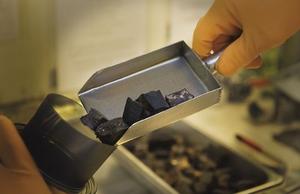Oxide conversionProblems continue to plague the Oxide Conversion Facility at Y-12
Oxide conversion is critical to recycling weapons-grade uranium, making it useful in nuclear warheads or for other purposes. The Oxide Conversion Facility (OCF) at the Y-12National Security Complex has been operating inconsistently in recent years. A report by the staff of the Defense Nuclear Facilities Safety Board(DNFSB) said there was a plan to resume operations the week of 7 April 2014, but that did not happen.

Reclaiming used uranium from disassembled weapons // Source: doe.gov
The Oxide Conversion Facility (OCF) at the Y-12 National Security Complex has been operating inconsistently in recent years. A report by the staff of the Defense Nuclear Facilities Safety Board (DNFSB) said there was a plan to resume operations the week of 7 April 2014, but that did not happen. “OCF remains out of service at this time,” said Steven Wyatt of the National Nuclear Security Administration (NNSA). The facility has not operated since March 2013.
Oxide conversion is critical to recycling weapons-grade uranium, making it useful in nuclear warheads or for other purposes. Uranium is transformed from an oxide form to uranium tetrafluoride, or green salt, which then goes through a reduction process to form purified uranium metal.
Knoxblog reports that the most recent issue at the facility was a small leak of hydrogen fluoride which occurred when operators were preparing to install a new HF cylinder for the oxide-conversion system, which led to multiple evacuations. OCF has been underperforming, and while there are other sources for purified uranium metal at Y-12, the OCF is the preferred means of recycling scrap of weapons-grade uranium.
A 28 March 2014 report by the DNFSB said, “enriched Uranium Production personnel continue to progress in their efforts to resume operations at OCF. Last week, craft personnel replaced the valve stem assembly that system engineers believe was the source of a leak in the primary confinement barrier of the vaporizer enclosure (where alarms had been detecting hydrogen fluoride). The system subsequently passed a helium leak check and pressure decay test. Operators must now complete a small set of surveillances before OCF can return to operation.”
In anticipation of the OCF resuming operations, “enriched Uranium Production personnel produced nearly double the quantity of purified UO3 (the feed material for the Oxide Conversion Facility) relative to the quantity produced during the first seven months of the fiscal year combined.” Since the OCF is not operating, however, the production of uranium metal has been stalled.
Officials at Y-12 are developing other technologies to replace OCF. Oak Ridge National Laboratory director Thom Mason, head of the Red Team assigned to evaluate alternatives for carrying out Y-12’s uranium objectives, recommended using Y-12’s Beta-2E facility to conduct uranium recovery operations with electro-refining (ER) and direct electrolytic reduction (DE). Mason suggested that his recommendations should be in place before the 9212 uranium complex at Y-12 shuts down in 2025. One argument for building the OCF was that it would allow the phasing out of the deteriorating 9212 complex.
